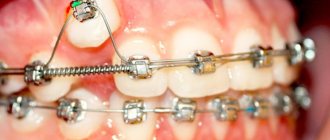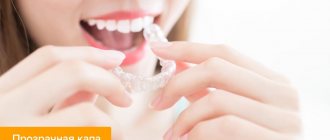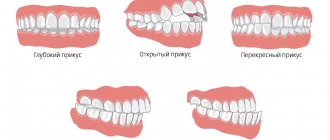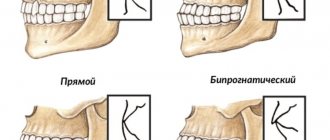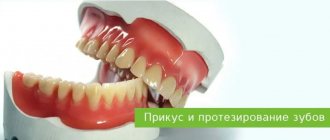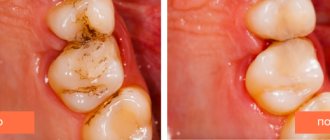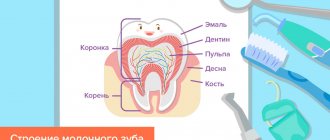What does the trainer look like?
A trainer is a two-jaw mouthguard made of silicone or polyurethane. The design consists of arches for the dentition with recesses for individual teeth, a tongue that corrects the position of the tongue and a lip bumper. Such a device is not made individually; the orthodontist selects a suitable model for the patient. Trainers, depending on the type and manufacturer, may differ in size, width, and length of the arch for the dentition.
Bottom line
Problems with bite and other dental defects affect every second person in the modern world. Natural deficiencies in the anatomical structure of the jaw, injuries and bad habits can be corrected with the help of orthodontics. Plates and braces have been replaced by special dental trainers - orthodontic trainers, which effectively correct underdeveloped facial skeletons and other jaw pathologies. The affordable price, trouble-free operation of the trainers and easy care allow every adult and child to solve problems with dental pathologies.
The absence of metal parts and the elasticity of the material are a huge advantage of trainers over other orthodontic systems. The principle of operation of the simulators is not aimed at eliminating symptoms, but at eliminating the causes of pathological development of the jaw. This is an innovative development that prevents relapses during dental correction. Now you can correct not only your smile line, but also get rid of bad habits, overcome snoring and correct abnormal mouth breathing.
Sources used:
- Manufacturer's official website
- Vanarsdall,RL and White,RPJr. — Replais & Retencion: Professional and public attitudes, Am.J.Orthod. 98:184, 1990
- — Principles of retention in orthodontia
How does the trainer work?
The trainer is put on both rows of teeth, the teeth fall into special recesses. Thus, the jaws and teeth are gently fixed in the correct physiological position - the mouth guard prevents them from taking the usual incorrect position. The device works as a simulator for the masticatory muscles and tongue, teaching them to perform correct, physiological work. An important function of a trainer is to correct and prevent the development of bad habits in children.
The lip bumper prevents unconscious finger sucking in sleep and prevents you from touching your teeth with your hands. The protrusion inside in the center of the arch fixes the tongue in the correct position - does not allow the tongue to remain between the dentition (prevents the formation of an open bite). The massive design itself promotes proper breathing - through the nose.
Appearance
The t4k trainer is a special orthodontic design. It is made of silicone - a soft and elastic material that does not cause discomfort when worn, does not put pressure on the lower and upper jaw and does not cause other unpleasant sensations that occur immediately after installing a conventional trainer.
It has a neat and laconic design and is available in different colors. But keep in mind that the division by color is different from the usual: when you see a pink T4K trainer, you shouldn’t assume that this is a copy for girls, and a blue one for boys. The color of the product is associated with the stages of treatment, more on that below.
The trainer also has special design elements that increase the effectiveness of treatment - a recess for the dentition, a tongue, labial arches, a lip bumper and a tongue stop. Thanks to these components, the little patient gets used to the correct position of the jaw, lips, tongue during the active phase (chewing food, speaking) and passive (resting state), and quietly conducts myofunctional training, which helps improve speech, bite and facial features. And, importantly, the child learns to breathe correctly, through the nose, thereby improving the functioning of the respiratory system.
Who is the trainer for?
Trainer for children
The trainer is intended for early treatment of children who still have baby teeth or are just beginning to erupt permanent teeth. The action of the mouth guard is quite mild, so it is effective only for a growing body during the period of active formation of jaws, muscle and teeth growth.
Trainers can be used from about 6 years of age. The mouthguard prevents the formation of dental-facial pathologies, corrects minor curvatures and crowding of teeth, and forms correct habits.
Before and after wearing the trainer for 4 months
Pre-orthodontic trainer
Removable silicone aligners are often used as preparation for subsequent orthodontic treatment with braces, plates or aligners. The pre-orthodontic trainer is used to develop good habits, reinforce the correct position of the tongue, lips and muscle growth.
The complex effect of the device prevents improper growth of teeth and the formation of malocclusion, promotes the development of proper breathing and slightly changes the position of the teeth. Pre-orthodontic trainers are used from the age of 5 and significantly reduce the duration and complexity of treatment with braces in the future. With a simple clinical case and responsible wearing of the trainer, you can do without installing a brace system in the future, but the final conclusion is given by the doctor.
Types of Myobrace Starter pre-orthodontic trainers:
- The initial pre-orthodontic trainer T4K (blue) is a soft device that can adapt to almost any initial position of the teeth.
- The final pre-orthodontic trainer T4K (pink) is a more rigid mouthguard that fixes the result of alignment with the initial trainer into a stable position.
Myobrace trainer with rigid frame
This type of trainer is used during the period of mixed or permanent dentition to correct the position of teeth due to a rigid structure made of nylon and silicone with individual cells for each tooth. The series of trainers is available in 7 sizes for different ages, starting from 10-12 years. Even a hard trainer will not be able to replace braces for complex malocclusions, but it is quite capable of correcting the position of a separate tooth.
Trainer for adults
Mouthguards do not correct bites and uneven teeth in adults because they cannot provide a strong enough mechanical effect on the teeth. Adults may be prescribed trainers as a retention guard after removing braces or as a means of eliminating minor relapses after orthodontic treatment.
Frameless trainer Myobrace
Myobrace No Core Flexible Trainers are most often used as a retention night guard at the end of orthodontic treatment in adults. The device helps improve occlusal contacts and stable teeth position. The trainer is also available in 7 sizes.
Bite defects in children
Children and teenagers often develop malocclusion, which is caused by incorrect positioning of the tongue and lips. If the baby is raised on artificial nutrition or has used a pacifier for too long, a malocclusion is guaranteed. Incorrect position of the lips and tongue is caused by the habit of putting the thumb in the mouth during sleep or during the day, and the habit of pulling various objects into the mouth.
Parents must promptly recognize the onset of malocclusion in order to take timely measures. Signs of developing pathology are:
- irregular face oval;
- separation of teeth in different parts of the jaw;
- parted lips;
- protruding tongue forward when swallowing;
- pathologies of teething;
- grimaces.
An irregular oval of the face can be noticed immediately: the face takes on an elongated shape or the lower part looks shortened. In profile, the head looks convex or concave. Often a child develops asymmetry: one part of the face visually looks larger than the other. The cause of the deformation may be a jaw that is too small or too large, or an abnormal inclination of the teeth.
How to determine the separation of teeth in a child? You need to ask the baby to close his teeth. With a properly formed bite, the upper teeth slightly cover the lower ones. If the upper teeth protrude forward (more than 1/3 of the length), this indicates pathology. The causes of this pathology can be bad habits: the position of the tongue between the upper and lower teeth, the inability to breathe through the nose, or prolonged pacifier/thumb sucking.
Parted lips are easy to notice - the baby constantly walks with his mouth open. If you ask a child to close his mouth, muscle tension can be seen. The cause of this pathology is mouth breathing or loose teeth.
When pushing the tongue forward during swallowing, the child constantly rests the tip of the tongue on the lips instead of the front teeth. This pathology is a consequence of the infantile type of swallowing inherent in infants. If the pathology is not corrected, multiple orthodontic problems may subsequently develop.
Grimaces on a child’s face appear when the facial muscles are overly tense. Characteristic folds appear on the cheeks and near the lips, and the chin becomes tense.
Pathologies of teething can be due to improper feeding (only liquid and pureed foods are on the menu) or due to injury to the jaw. The child may not have teeth for a long time, or the molars may begin to grow in the wrong position.
How and for how long to wear trainers?
Since the trainers are quite massive, they are worn only at night and for 1-4 hours during the day. The patient may experience pressure and a little pain at first.
Mouthguards work and correct teeth only when worn regularly and visible results appear after 6-12 months.
Even with regular use of the trainer, additional orthodontic treatment with braces or aligners may be required after it - it all depends on the complexity of the clinical case.
If a child does not wear a trainer regularly, orthodontists recommend installing permanent partial braces. They will work in your mouth 24 hours a day and will definitely give results.
The retention period trainer is also worn at night and is terminated according to the treatment plan.
Reviews
The majority of patients and their parents are satisfied with the results of treatment using the T4K pre-orthodontic trainer. Everyone notes its convenience and ease of use, as well as greater efficiency.
You can share your experience of using both types of this device by leaving a comment below.
If you find an error, please select a piece of text and press Ctrl+Enter.
Tags: bite correction, bite trainers for children
Did you like the article? stay tuned
Previous article
Dental varnish: how does it work, who is it suitable for?
Next article
Deep bite: general information
Trainer care rules
It is imperative to clean the trainer after each use - this directly affects the health of your teeth and the service life of the device.
Fortunately, trainers are easy to clean, unlike fixed structures - they can be removed and simply washed under running water. But due to the nature of the material, several important rules must be followed when cleaning the trainer:
- Do not rinse the trainer with too hot or cold water - the silicone or polyurethane may be deformed, the device will lose its shape and its main function of straightening teeth.
- Do not rub the trainer too hard with hard objects, scratch or stretch it. The same rules must be followed while wearing the appliance: do not talk to it, do not chew or try to change the fixed position of the teeth. Otherwise, the trainer will not work and influence the teeth correctly.
- Periodically, the trainer needs to be washed with soap or cleaned with toothpaste, since running water does not always wash away all contaminants; bacteria form on them and cause caries.
- Trainers are stored in a special plastic container so that it does not become deformed or become dirty until it is used.
Before and after wearing the trainer for 10 months
For whom is it intended?
T4K trainers are designed for a specific group of patients. These are children from 5 to 12 years old.
Such designs are prescribed if :
- the child was diagnosed with a connection of teeth in one place where the lower jaw incisors grow;
- with deep bite;
- if the child has an open bite in the central area;
- Engel class I, II and mildly manifested III;
- incorrect position of the lower jaw;
- bad habits of the child (difficulty breathing, sucking foreign objects, improper swallowing), as well as difficulties in pronouncing words and letters;
- The lower jaw is positioned incorrectly and unnaturally.
